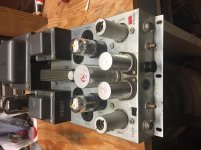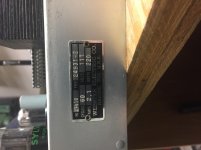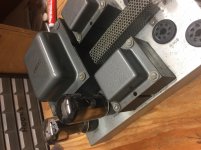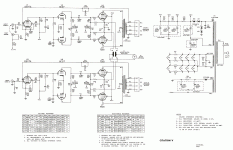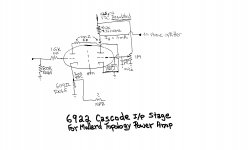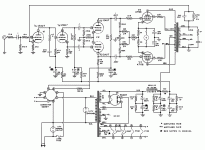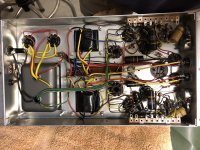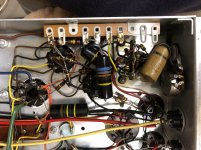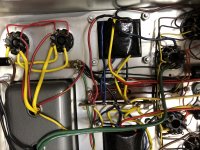I recently bought this Webster amp that I believe came out of an organ.
It appears to be two single channel amps as it has two volume controls.
If the capacitors and the missing tubes were replaced, would there be value in turning it into a pre amp or power amp? I understand Webster were well regarded.
It appears to be two single channel amps as it has two volume controls.
If the capacitors and the missing tubes were replaced, would there be value in turning it into a pre amp or power amp? I understand Webster were well regarded.
Attachments
You've got a lot to work with, in ending up with a nice stereoblock power amp. A pair of 5U4GB rectifiers is not "Cheap Charlie".  The "iron" seems substantial too.
The "iron" seems substantial too.
Russian 6Π3C-E (6p3s-e) O/P tubes (a nice 5881 equivalent) will work well. Forget about Webster's circuitry and go tried and true Mullard style. A superior implementation of Mullard style is the Harman-Kardon Citation V. You will get somewhat less power, but that's NBD. The 6SN7 is electrically equivalent to the 6CG7 shown. The 12BY7 is getting scarce and I've provided a 6922 (in production) cascode to take its place.
Regardless of which signal topology you settle on, all electrolytic caps. currently in place have to go. FWIW, a "quickie" Google search did not turn up the OEM schematic.
BTW, you should get a few "coins" for the 12AY7s, if they test strong.
Russian 6Π3C-E (6p3s-e) O/P tubes (a nice 5881 equivalent) will work well. Forget about Webster's circuitry and go tried and true Mullard style. A superior implementation of Mullard style is the Harman-Kardon Citation V. You will get somewhat less power, but that's NBD. The 6SN7 is electrically equivalent to the 6CG7 shown. The 12BY7 is getting scarce and I've provided a 6922 (in production) cascode to take its place.
Regardless of which signal topology you settle on, all electrolytic caps. currently in place have to go. FWIW, a "quickie" Google search did not turn up the OEM schematic.
BTW, you should get a few "coins" for the 12AY7s, if they test strong.
Attachments
Thanks Eli
There's a company just over the border in Spokane WA that specialize in electric organs who can test and supply the tubes. Next time I'm down that way I'll drop in.
Do I gather then that this is worth working with, with the alternative tubes you suggest along with cap replacement. I assume not a problem having two volume controls?
Regards John L.
There's a company just over the border in Spokane WA that specialize in electric organs who can test and supply the tubes. Next time I'm down that way I'll drop in.
Do I gather then that this is worth working with, with the alternative tubes you suggest along with cap replacement. I assume not a problem having two volume controls?
Regards John L.
The twin rectifiers look good. The "iron", AKA magnetics, look good. "Everything" else is (IMO) who cares, as a superior "Golden Age" setup can be easily adapted to what is available.
Before crossing the border, contact Jim McShane. Jim's prices for thoroughly tested/matched tubes are fair. Also, Jim has a BC contact who understands HIFI. There are substantial differences between instrument amps and HIFI amps. That store in Spokane may unintentionally steer you wrong.
"Restomod" work, like that under discussion, does not come cheap. If you can DIY, your bank balance will benefit. Once again, Jim McShane can help with parts. Of course, the giants such as Mouser, DigiKey, and Allied are parts sources too.
Before crossing the border, contact Jim McShane. Jim's prices for thoroughly tested/matched tubes are fair. Also, Jim has a BC contact who understands HIFI. There are substantial differences between instrument amps and HIFI amps. That store in Spokane may unintentionally steer you wrong.
"Restomod" work, like that under discussion, does not come cheap. If you can DIY, your bank balance will benefit. Once again, Jim McShane can help with parts. Of course, the giants such as Mouser, DigiKey, and Allied are parts sources too.
I recently bought this Webster amp that I believe came out of an organ.
It appears to be two single channel amps as it has two volume controls.
If the capacitors and the missing tubes were replaced, would there be value in turning it into a pre amp or power amp? I understand Webster were well regarded.
This is a nice amp. I would use film caps in power-supply and you can buy the panasonic or Wima film caps at mouser in the values you need very reasonable and they will glue nicely with goop under the chassis. The Iron is 6.6k as I recall and it is made by Stancor as I recall. I did measure a Webster opt one time that was mono with 4 6L6gs. You can build nice 30 to 35wpc amp here and Eli has great suggestions on this stuff and the reason I say use film caps, they always have given the amplifier more energy,at least in my applications although there are very good lytics too. You won't want to overdo the filtering on the first stage but you might also consider using Schottky diodes. Eli's cascoded 6922 is an excellent idea because of the high GM. I love this amp.
Last edited:
Mike is correct about film caps. being nice. Unfortunately, they occupy more space than 'lytics for a given amount of capacitance and that can be trouble. Maybe we can "shoehorn" a film cap. in as the thing the 5U4s feed 1st. That 1st capacitance can't be big, when vacuum rectification is used, and a film part is very useful there. High grade (low ESR), industrial, electrolytics from Panasonic and Nichicon are nipping at film parts' heels and will work well where high volumetric efficiency/amount of capacitance is needed.
In any event, the membership here will get you going, whether you go full bore DIY or farm the work out to a competent technician. The "iron" makes the amp and the stuff you have is nice. A highly satisfactory end result rates to be achieved.
In any event, the membership here will get you going, whether you go full bore DIY or farm the work out to a competent technician. The "iron" makes the amp and the stuff you have is nice. A highly satisfactory end result rates to be achieved.
Webster amp
Why can't you just use the amp as is can't see why you need to use a different circuit. May be worth changing a few caps and check the electrolytics.
Best to fire it up with a lamp globe in series.
I would try it as is before spending money to change the circuit.
Best To get some one used to tube circuits to help you get it going.
I found this thread; New build based on Webster/Allan organ amp
Why can't you just use the amp as is can't see why you need to use a different circuit. May be worth changing a few caps and check the electrolytics.
Best to fire it up with a lamp globe in series.
I would try it as is before spending money to change the circuit.
Best To get some one used to tube circuits to help you get it going.
I found this thread; New build based on Webster/Allan organ amp
Why can't you just use the amp as is can't see why you need to use a different circuit.
Several attempts at locating the OEM schematic have been fruitless.
Also remember that the original circuit was designed as an organ amplifier, and as such its bandwidth and distortion performance may not be up to par.
All coupling capacitors need to go (they're almost certainly leaky at this point), as do the electrolytic caps. As Eli mentioned, the 12AY7 tubes could be worth a pretty penny depending on what they are (and if they test good!). Also, just some interesting trivia: I believe the Neumann U67 used a 12AY7 (much more obtainable than the VF14 in the U47/U48).
I second the Mullard topology suggestion, and if you're clever, I bet you could make that existing chassis look pretty darn nice as well with a little cleaning and some wood side panels. All in all, not a whole lot of work for what you'd get out of it. Any chance we could get a pic of the underside?
All coupling capacitors need to go (they're almost certainly leaky at this point), as do the electrolytic caps. As Eli mentioned, the 12AY7 tubes could be worth a pretty penny depending on what they are (and if they test good!). Also, just some interesting trivia: I believe the Neumann U67 used a 12AY7 (much more obtainable than the VF14 in the U47/U48).
I second the Mullard topology suggestion, and if you're clever, I bet you could make that existing chassis look pretty darn nice as well with a little cleaning and some wood side panels. All in all, not a whole lot of work for what you'd get out of it. Any chance we could get a pic of the underside?
FWIW, I have a hunch that the circuitry Webster used resembles that of the self biased Williamson style found in the Heath W5M. It's the 12AY7 that has me doing some head scratching. There is nothing wrong with Williamson style. Just be sure to space the low pass poles out and employ GOOD O/P "iron", to avoid its "Achilles Heel" of low freq. instability.
Photos of the "guts" will provide a clue about whether or not a bias supply rectifier is already present.
Mullard style is more forgiving of so/so O/P trafo quality than Williamson style. However, Mike Samra's Stancor remark is encouraging in the "iron" quality dept. A 6FQ7/6CG7 as the voltage amplifier/phase splitter and a 6SN7 as the differential gain block are a darned good mechanical fit for that chassis. Having options among "classic" topologies is (IMO) a nice position to be in.
Photos of the "guts" will provide a clue about whether or not a bias supply rectifier is already present.
Mullard style is more forgiving of so/so O/P trafo quality than Williamson style. However, Mike Samra's Stancor remark is encouraging in the "iron" quality dept. A 6FQ7/6CG7 as the voltage amplifier/phase splitter and a 6SN7 as the differential gain block are a darned good mechanical fit for that chassis. Having options among "classic" topologies is (IMO) a nice position to be in.
Attachments
AS no one has found the circuit how do you know the circuit is a poor one?
Is very easy to replace the coupling capacitors and electrolytic s without knowing the circuit.
Much more difficult to rebuild a new circuit for a beginner. I can't imagine the cost of having it done.
Is very easy to replace the coupling capacitors and electrolytic s without knowing the circuit.
Much more difficult to rebuild a new circuit for a beginner. I can't imagine the cost of having it done.
Other than the negative fact of being instrument, not HIFI, the OEM circuit is an unknown quantity. OTOH, the "classic" topologies previously mentioned are well proven music reproducers. Also, no suggestion of "butchering" the existing mechanical engineering package is being made. As is the OEM case, what's been suggested is 1 Noval and 3 Octal tubes in each channel.
We'll know more once we see the underside. If it is in pristine condition (pretty easy to tell), then simply recapping it and giving it a test may be worth doing, even without a schematic.
However, if you don't have the original schematic, dealing with a circuit that's been tampered with can be a never-ending goose chase that is not worth one's time. You don't know what's right and what's wrong, and you need to trust that whoever modded it knew what they were doing (I wouldn't bet on it).
A more pressing issue is what this circuit was designed for. As mentioned previously, organ amplifiers are not known for being great HiFi amplifiers (There are exceptions, I believe Allen comes to mind). This can be verified by testing, but such testing may not be an easy procedure depending on the condition, and in all likelihood some modification would be required.
A good portion of the wiring for a new circuit is already in place, so rebuilding it with Mullard topology probably wouldn't be very much harder (and may actually be easier) than adapting the existing circuit. The most difficult part (IMO) is feedback optimization and stability testing, which would probably be worth doing regardless.
However, if you don't have the original schematic, dealing with a circuit that's been tampered with can be a never-ending goose chase that is not worth one's time. You don't know what's right and what's wrong, and you need to trust that whoever modded it knew what they were doing (I wouldn't bet on it).
A more pressing issue is what this circuit was designed for. As mentioned previously, organ amplifiers are not known for being great HiFi amplifiers (There are exceptions, I believe Allen comes to mind). This can be verified by testing, but such testing may not be an easy procedure depending on the condition, and in all likelihood some modification would be required.
A good portion of the wiring for a new circuit is already in place, so rebuilding it with Mullard topology probably wouldn't be very much harder (and may actually be easier) than adapting the existing circuit. The most difficult part (IMO) is feedback optimization and stability testing, which would probably be worth doing regardless.
Last edited:
- Status
- This old topic is closed. If you want to reopen this topic, contact a moderator using the "Report Post" button.
- Home
- Amplifiers
- Tubes / Valves
- Webster tube amp
